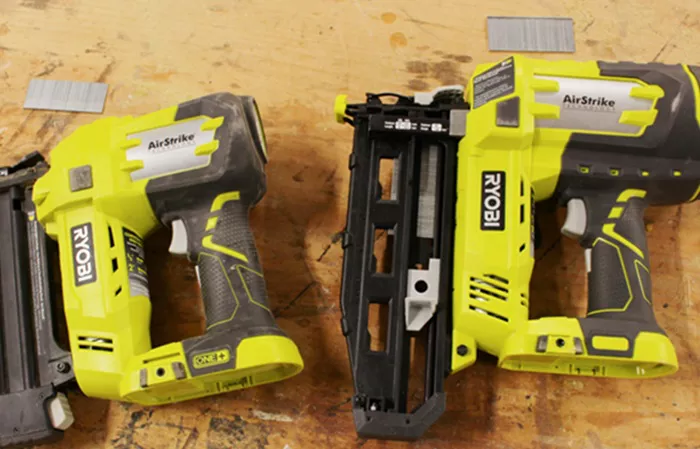A brad nailer is a specialized tool designed for fastening small, thin nails, known as brads, into various materials. It is commonly used in woodworking and finishing applications due to its ability to provide precise, clean, and unobtrusive fastenings. This tool is particularly favored by professionals and DIY enthusiasts for tasks that require delicate and accurate nailing without leaving noticeable marks. Understanding the functions and Usage of a brad nailer can help in selecting the right tool for specific projects and achieving high-quality results.
1. Trim and Molding Installation
Precision Nailing: A brad nailer is ideal for installing trim and molding because it uses small brads that don’t split the wood. This precision is crucial for achieving a clean finish, especially when working with delicate or thin trim pieces.
Minimizing Damage: Unlike larger nails, brads from a brad nailer leave smaller holes, which reduces the need for extensive sanding and filling. This feature is particularly beneficial when working with high-quality or finished wood, where maintaining an immaculate appearance is essential.
Ease of Use: The lightweight and compact nature of a brad nailer makes it easy to handle, allowing for accurate placement of nails in tight spaces and corners. This ease of use enhances productivity and results in a professional finish.
2. Cabinet and Furniture Assembly
Holding Power: In cabinet and furniture assembly, a brad nailer provides effective holding power for attaching smaller components, such as trim, panels, and decorative elements. The small brads ensure that the parts stay securely in place without causing damage.
Invisible Fastenings: The small size of brads allows them to be used in visible areas without being obtrusive. This is especially important in furniture assembly, where maintaining the aesthetic quality of the piece is crucial.
Quick and Efficient: A brad nailer speeds up the assembly process by quickly driving brads into the material, which helps in achieving a seamless and efficient workflow. This efficiency is valuable in both professional and DIY settings.
3. Paneling and Wainscoting
Secure Attachment: Brad nailers are used to attach paneling and wainscoting to walls. The small brads provide a secure hold while minimizing the impact on the surface, ensuring that the paneling stays in place without damaging the material.
Clean Finish: The use of a brad nailer helps in achieving a clean and professional finish on paneling and wainscoting projects. The small brads leave minimal marks, which reduces the amount of touch-up work needed after installation.
Versatility: A brad nailer can handle various types of paneling and wainscoting materials, making it a versatile tool for different design preferences and construction needs.
See also: What Is An Impact Driver Used For?
4. Craft and DIY Projects
Precision for Small Projects: For craft and DIY projects, a brad nailer is ideal due to its precision and ability to handle small nails. This makes it suitable for assembling intricate projects, such as small furniture pieces, decorative items, and detailed woodworking tasks.
Minimal Impact: The small size of brads ensures that they do not interfere with the visual appeal of crafts and DIY projects. This minimal impact is crucial for maintaining the overall aesthetic of the finished product.
Ease of Handling: The lightweight and user-friendly design of a brad nailer makes it accessible for DIY enthusiasts, allowing for precise and efficient work on a variety of small-scale projects.
5. Panel and Sheet Material Attachment
Efficient Nailing: When working with panel and sheet materials, such as plywood or MDF, a brad nailer provides a quick and effective means of securing the panels. The small brads ensure that the panels are held firmly without causing damage to the material.
Reduced Splitting: The use of a brad nailer helps to prevent splitting in delicate panel materials, which is common with larger nails. This feature is especially beneficial when working with thin or fragile sheets.
Finishing Touches: Brad nailers are useful for adding finishing touches to panel installations by providing a clean and secure attachment that enhances the overall appearance of the finished project.
6. Door and Window Casings
Accurate Nailing: Brad nailers are used for installing door and window casings, where precision is key. The small brads allow for accurate placement without affecting the surrounding areas, ensuring a snug fit and clean finish.
Non-Damaging Fastening: The use of brads minimizes the risk of damaging the casings or the surrounding trim, which is essential for maintaining the integrity and appearance of door and window installations.
Professional Results: A brad nailer helps achieve professional results by providing a secure hold with minimal visible evidence of the fasteners. This is important for maintaining a polished and high-quality look in casings.
Conclusion
A brad nailer is an invaluable tool for a variety of applications, from trim and molding installation to furniture assembly and craft projects. Its ability to drive small, thin brads with precision and minimal impact makes it ideal for tasks that require a clean, professional finish. By understanding the specific uses and advantages of a brad nailer, users can make informed decisions and achieve high-quality results in their woodworking and construction projects. Whether for professional work or DIY endeavors, a brad nailer provides the efficiency and precision needed to enhance the quality of the finished product.
Related Topics:

